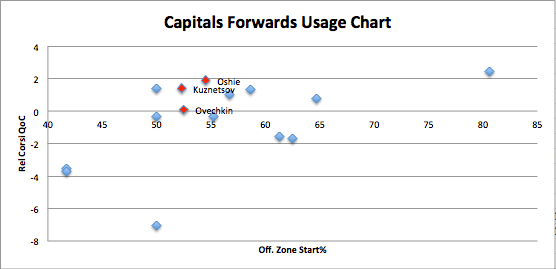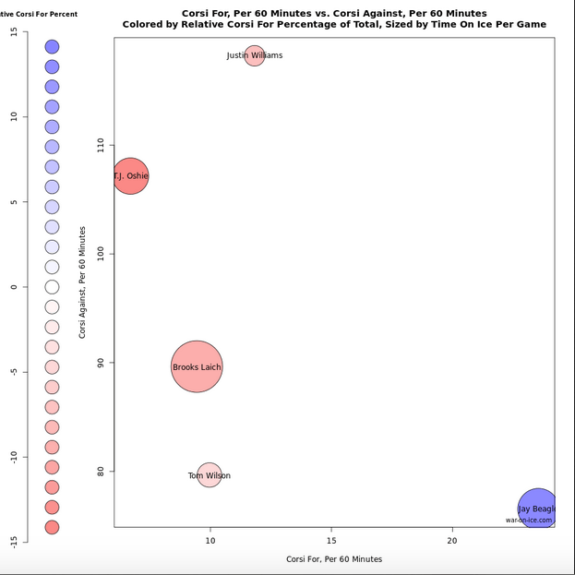It has been a glorious start to the season so far for the Washington Capitals. The team is 4-1-0 and has rolled through three straight wins outscoring the opposition 14-4. With such a recent run of dominance, it is time to check with the analytics to see if Washington has what it takes to be a contender. Along with that, it is also a good time to see if there have been many changes to the Capitals team throughout these first five games in comparison to last year.
1. Alzner and Niskanen are now the team’s shutdown pair.
Last season, the distinction of the defenseman pair that received the toughest zone starts and the hardest competition was the John Carlson-Brooks Orpik pairing. While those two have handled such assignments throughout their careers, their overall puck possession was not great. At 35 years old, Orpik’s shot attempt percentages have worsened and while it hasn’t hit a crisis point, odds are it will not get better anytime soon throughout the remaining four years of his contract.
Meanwhile, John Carlson has been nothing short of remarkable analytically. With such tough assignments and with an aging defensive partner usually by his side, the 25-year old was able to generate over 59% of the on-ice shot attempts in his favor. So it’s pretty clear that not much can phase him at the NHL level and he should be regarded as one of the most well-rounded defensemen in the league.
That being said, Karl Alzner and Matt Niskanen were also brilliant in their first year pairing up last season. While together at even strength, the two had 51.9% of the total shot attempts go in their favor with relative zone starts also below zero percent. Meanwhile, the Orpik-Carlson pair only generated 49.7% of their on-ice shot attempts last season. So it makes sense to see if the two roles should be reversed for this season and so far it has done wonders.
With Alzner and Niskanen receiving the toughest zone starts, the two are close to their puck possession numbers from last year at 51.3% when together. What’s changed is the fact that Orpik and Carlson, with more offensive starts, are producing 53.6% of their on-ice shot attempts in their favor. With the third pairing looking effective, but still developing, this is certainly an upgrade for the blue line and the team in general.

2. And so is the first line?
This is where things get interesting. Last season, Washington’s closest thing to a shutdown forward line was one that consisted of Eric Fehr, Brooks Laich and Joel Ward. While that worked for a decent period of time during the December and January months, the line began to falter in February and had to be separated without being brought together again the rest of the season. Now, Fehr and Ward are with other teams and while you can create a shutdown line with Laich, he is an aging two-way forward that has gone through one too many injuries over the past three seasons.
With that in mind, Trotz so far has allowed his shutdown line to be his top line of Alex Ovechkin, Evgeny Kuznetsov and T.J. Oshie. While last season’s top line of Ovechkin, Nicklas Backstrom and Mr. Insert Any Name Here usually received the toughest quality of competition, they were usually implemented with more favorable offensive zone starts to drive their goal scoring production. Such deployments are very common for any top line throughout the NHL.
However, the third line of Chimera, Tom Wilson and Jay Beagle, has actually received better zone starts than the top line and have been absolutely destroyed in the puck possession department. So far, not a single forward in that line has received a relative shot attempt percentage better than -14%. Meanwhile, the second and fourth lines have actually been given much more frequent zone starts in the offensive zone while dealing with weak quality of competition.
Look out for this if the Capitals go through a long losing streak. Oshie is certainly surrounded by linemates with better skill than he was in St. Louis, but his assignments are just like when he was teamed up with David Backes and Alexander Steen. It can’t be iterated enough that while the overall talent of the top six is better, the talent on the third and fourth lines might actually be worse and thus the balance of the lineup might still not be at it’s most ideal.

3. Is Brooks Laich rejuvinated?
Well look who is leading all Capitals forwards at relative shot attempt percentage at even strength! At 33.7% more of the shot attempts going in his favor when he’s on the ice versus off the ice, Laich has been off to a great start to the season despite not recording a single point and having a -2 plus-minus.
Now there are plenty of things going in his favor. He is currently facing the 6th easiest quality of competition on the team based on opponents relative puck possession. Also, his linemates he shares the ice most frequently so far this season wouldn’t be considered those in the realm of bruising bottom six forwards. As of now, his top five linemates in terms of minutes played together are rookie Chandler Stephenson, Andre Burakovsky, Marcus Johansson, Stanislav Galiev and Justin Williams. The amount of stereotypical grit on this team has certainly decreased this season, but if Laich can stay with these type of teammates, goals will come and hopefully his puck possession will still stay above 50% for the entire season.
4. How are the new penalty killers?
With Ward, Fehr and Troy Brouwer gone from last year, so was the majority of the minutes from the team’s penalty kill. One of the biggest fears coming into this season was how good was the unit going to be with newcomers demanded to pick up these roles that were left behind.
So far, it has been brilliant. Right now, the Capitals are giving up 87.5 shot attempts per 60 minutes while shorthanded; good for a respectable 12th in the NHL. Along with that, Washington has 13 of the 15 shorthanded opportunities.
This season, Oshie, Williams and Wilson have joined Laich and Beagle as the teams main penalty killers at forward. As of now, Beagle has once again been the team’s main threat in shorthanded shot generation while Wilson has actually done a surprisingly good job at shot suppression so far. While Oshie and Williams will certainly not have two-way forward in their job descriptions, both players have experience on the penalty kill on teams that are the best in the NHL in shot suppression in all facets. It can be difficult whether their individual talent or their previous team’s system has made them good forwards while shorthanded, but at least bringing such knowledge to a team starved of great penalty killers throughout the 21st century couldn’t be a hindrance either.

5. So are the Caps better?
So with all these interesting observations throughout the Capitals lineup, has anything changed to make the Capitals a better team?
Outside of the penalty kill, not a ton has changed. The power play is still generating over 110 shot attempts per 60 minutes and the offense at five-on-five is consistently within the mid 50s per 60 minutes. However, the shot suppression at even strength has been immense. So far, their 47.8 shot attempts against per 60 minutes is good enough for 6th in the NHL. This is a massive improvement considering they were 14th in that category last season. In a league where defense is key, it is important that Washington continues to improve in this department in order to win a Stanley Cup.